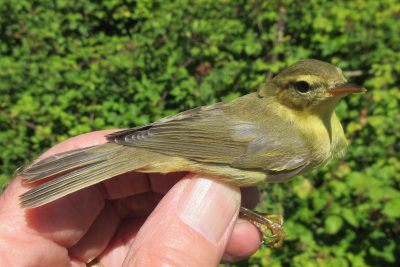
Willow Warbler (juvenile), Longham Lakes 30/07/2020 (Roger Peart.)
30th July
A relatively good ringing session, with 17 new birds and 1 re-trap. 10 of the new ones were Reed Warblers (1 adult, 9 juveniles) and the others were singles of Blackcap, Garden Warbler, Willow Warbler, Robin, Wren, Blackbird and Song Thrush. All were juveniles, except the Song Thrush which was an adult in moult. Another Garden Warbler was good though – and the one re-trap was the Garden Warbler I ringed last week! There were lots of Common Blues, Meadow Brown, Gatekeeper. On the South Lake I counted 22 Great Crested Grebes, which seemed a lot more than I have previously seen. Also a Brown Hawker that got caught in the nets
One slightly disturbing thing was that someone was flying a very large model seaplane over the eastern end of the lake at about 9am (might have been their earlier before I was looking) and went on for about an hour (Roger Peart.).
Very active male Lesser Emperor still present on North Lake at east end of the causway at 1.45pm but no sign of it ar 3.30pm. Otherwise surprisingly low numbers of Odonata present this afternoon (George Green.)
23rd July
Visited Longham Lakes this am. Yet more Lesser Emperors with at least 3 males present. One at the south end of the the South Lake showing from the gap in the lakeside vegetation by the big dip in the footpath. The two others were disputing territory in the south-west corner of the North Lake near the end of the Causeway. Birdwise very quiet. Highlight was a Fulvous Whistling Duck on the North Lake. Presumably one of the two I saw at Sturminster Marshall GP a couple of weeks ago (George Green.)
22nd July
The Great Crested Grebes on their nest now have an egg (Sally Rufus.)
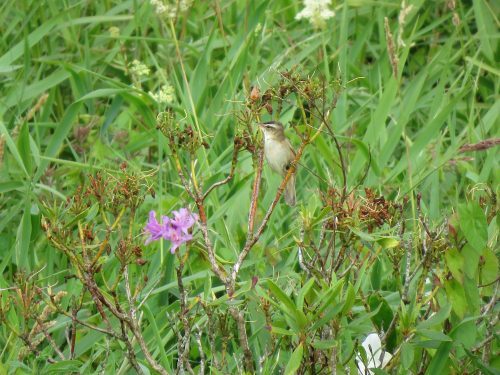
Sedge Warbler, Longham Lakes, 10/07/2020
10th July
Went down to the Lakes early this morning to bait for a catch. The Greylag Goose family were roosting on the larger, south lake around 5am. After baiting and enticing out from the canoe drop off, Charlotte successfully hand caught the gosling. This bird is now in safe hands with a lady called Lyn who lives down in Southbourne. She is visiting a vets today and will let me know the outcome. As the injury was sustained pre ringing it may be genetic or something that has happened at the Lakes itself. We have now ringed 95 Greylags at Poole Park and Longham as part of the project and this has by far been the most challenging in terms of recapturing under the circumstances. The fellow gosling, alongside its parents have now got full wings which means that they may leave the lakes as moulting is complete. Some of the Poole Park birds have started to disperse already so you never know, a few of them could turn up at the lakes within the next few weeks (Tom Weston, Poole Park Greylag Goose Project.) There was also a Sedge Warbler singing today, which is pretty late in the season, so it might be an unpaired bird (David Foster.)
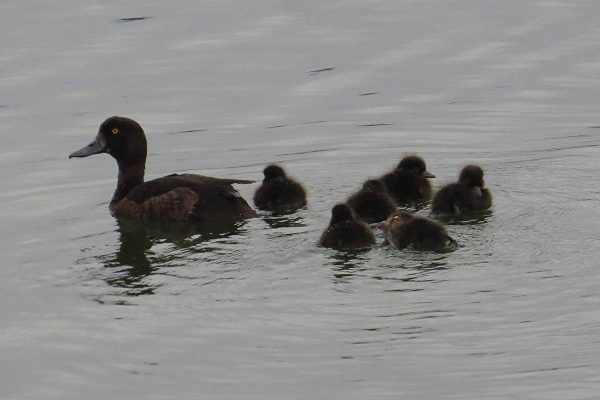
Tufted Duck female and chicks, Longham Lakes, 5 July 2020 (Roger Peart)
5th July
The Black-tailed Godwit was on the causeway happily prodding away at whatever it could find while the ducks and geese were just offshore on the north lake. Among those were at least two Tufted Duck mums with very tiny young – one had just one duckling and another had six. The most exciting thing was the large number of Swifts flying back and forth over the causeway – too difficult to count but at least 100, maybe quite a bit more. The Common Tern was active again, initially over the west end of the Causeway then down the east side of the south lake. Also flying very low over the south lake was a large number of Sand Martins, 50-100 I guess (Roger Peart.)
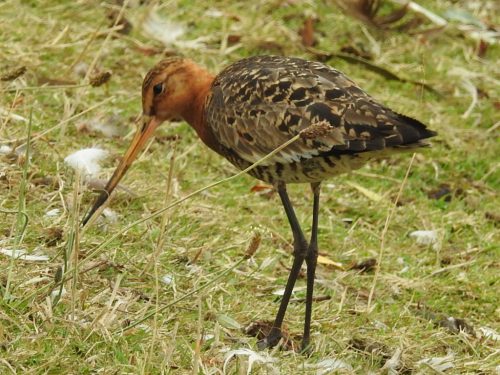
Black-tailed Godwit (juvenile), Longham Lakes, 01/07/2020 (Geoff Budden)
3rd July
Just a few sightings of modest interest from Longham Lakes this morning. The very tame juvenile Black-tailed Godwit is still present feeding along the shore of the Causeway. Also the very tame female Wigeon is still present along the causeway. Otherwise there was a pair of Egyptian Goose, a Common Tern and high numbers of Sand Martins (George Green.)
1st July
This morning around 10:00 am a Common tern made several low level forays along the east bank of the south lake. There was also a remarkably approachable Black-tailed Godwit feeding among the moulting ducks, Canada Geese and Mute Swans. At around 12:20, a Red Kite flew west. Lorne Bissell also found 2 Common Sandpipers. Later on the Godwit was still totally unfazed by the occasional passing walkers/joggers (it was very quiet). There were young of Canadas and Greylags every where on bank (and mess), a Tufted Duck with a very young chick on water (also Coot, Mute Swans, several Great Crested Grebes), Swifts overhead (only one Swallow seen), Sedges Warbler singing, Reed Warblers seen (Graham Willetts.)
29th June
Good numbers of Swifts and House Martins, probably 30-40 of each. Walking along the causeway between the lakes I regularly had Swifts dodging me at ground level – brilliant. Only a couple of Swallows though. (Terry White)
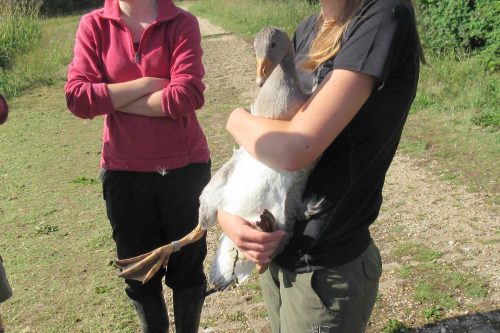 28th June
28th June
I joined Thomas Weston and three other young folk at 8am this morning to try to catch the Greylag Goose family for the Poole Park Greylag Goose Project. There was rather too much interference/competition from the Canadas so it took a while before we managed to capture the older gosling which was duly ringed. This gosling is bigger than its sibling and a metal ring was added to the bird’s right leg 5287453. The rings have both been added to the goslings right leg in case they turn up at Poole Park where a colour ring can be placed on the left leg. Due to the gosling being a bird of this year but not grown its flight feathers just yet the bird was aged as BTO 1. Biometrics taken for the bird showed the wing length of primary two was 149mm, this included the shaft and the feather of the bird compared to just the feather for the sibling last week. The tarsus and skull were also measured whilst the bird was in the hand and measured 96.9mm and 102mm respectively. These geese measurements can be compared to fellow goslings and Greylags to give a measure of size and growth. The bird was safely released with the family. Three quarters of the family are now ringed so there is a high likelihood these birds will be ring read in the future either at the lakes or somewhere different. Generally, Greylags remain as a family throughout the winter before the goslings disperse in the following spring when the adults breed again (Tom Weston, Roger Peart.)
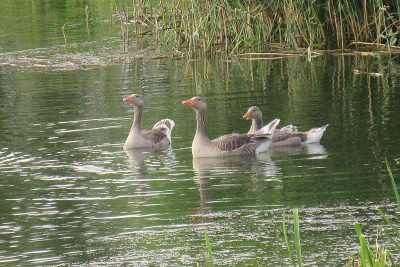 There were a large number of Swifts, House and Sand Martins over our heads most of the time. Back at the car park a Hobby was seen flying over. There were several Red Admirals on the bramble patches close to the ringing base while we waited for the geese to come near (Roger Peart.)
There were a large number of Swifts, House and Sand Martins over our heads most of the time. Back at the car park a Hobby was seen flying over. There were several Red Admirals on the bramble patches close to the ringing base while we waited for the geese to come near (Roger Peart.)
27th June
This afternoon there were lots of Swifts hawking over the lakes and causeway with a few Swallows, House and Sand Martins mixed in. There were 3 female Tufted Ducks with ducklings (1 with 3,) (1 with 1) and (1 with 6). A Common Sandpiper and Oystercatcher were on the large island on south lake. Insects found were Marbled White – 5, Red Admiral – 38 (with an impressive sight of 25 of resting on a grass path way and brambles out of the wind), Meadow Brown – 2, Four-spotted Chaser – 1, Common Blue Damselflies, Azure Damselflies and Oak Gall Wasp (Martin Wood.) There were at least 70 Swifts over later (Paul Beatson.)
26th June
A few birds of minor interest this morning. A single Oystercatcher was on the island but sadly without sign of any young. It seems likely that the young have been predated. On the positive side I found my first pair of Tufted Ducks with chicks this year. Tufties at Longham Lakes seem to leave it late to produce young. A count of 34 Great Crested Grebes seems unusually high for summer. Finally a Common Tern was present on the South Lake. Damsels & dragons: I managed to find 11 species involving the commoner species (George Green.)
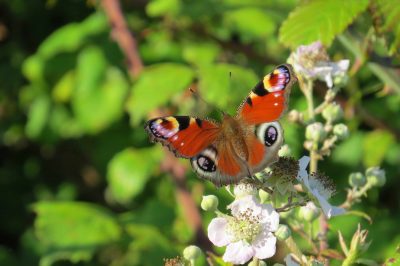
Peacock butterfly, Longham Lakes, 25 June 2020 (Roger Peart)
25th June
This morning, very early, at Longham (ringing session) – the birds were not obliging, just 7 ringed. New ones were a 1 year old male Blackbird, and the rest juveniles – Wren, Robin, Dunnock, Blackcap and two Greenfinches. The re-trap was a male Blackbird – first ringed in May 2017. Not the oldest we have had but still good to see him still surviving. Lots of Marbled White and Meadow Browns plus a single fine Peacock and my first Red Admiral of the year. Also a first ever moth – a Ruby Tiger, quite distinct in bright pink! (Roger Peart.)
24th June
Dragonflies today were: Banded Demoiselle 1 on each lake; Common Blue Damselfly c.400 combined estimate for both lakes; Blue-tailed Damselfly 1; Red-eyed Damselfly 1 distantly seen on SW pond [could have been Small Red-eyed]; Scarce Chaser c.20 on each lake [i.e. total about 40]; Broad-bodied Chaser 1 on SW pond; Emperor 3 on North lake; Golden-ringed Dragonfly 1 by south lake; Brown Hawker 1 on north lake; Common Darter 1 on south lake.
Butterflies: Meadow Brown c.300; Gatekeeper 2; Marbled White c.50; Small Skipper 20; Red Admiral 14; Comma 1; Peacock 3; Small Tortoiseshell 2; Silver-washed Fritillary 1 brief view, not quite certain (Steve Smith.)
21st June
Reports of a juvenile Black Tern today (David Foster.)
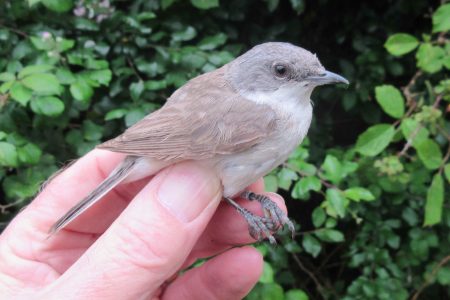
Lesser Whitethroat, Longham Lakes 18/06/2020 (Roger Peart)
18th June
There was a good ringing session this morning: 21 birds ringed (no re-traps) and quite a variety. There were 3 each of Robin (2 juveniles, 1 adult in moult,) Blackbird and Great Tit (1 adult male and 2 juveniles), 2 each of Wren (1 adult, 1 juvenile,) Dunnock (both adults,) Blackcap (both adult males) and Bullfinch (adult male and female caught together,) 1 each of Chiffchaff, Reed Warbler and Blue Tit – and the star attraction a Lesser Whitethroat. On recent visits I had been hearing and fleetingly seeing, what I took to be a Common Whitethroat around there. I am now thinking that it was this Lesser Whitethroat holding territory! Other interesting things: 5 Little Egrets flying in from the south, presumably from their roost, at about 0430, a Cuckoo calling in the far west between 0540 and 0550 and Large number of Swifts over the east end of the lake again – I noticed them from about 0630 and they were still there just before I left. Difficult to count but I reckon between 50 and 100 (Roger Peart.)
17th June
Birds today included , 4 Swift, Oystercatcher, Common Tern, 27+ Reed Warbler, 3 Swallow, 15+ House Martin, 3 Chiffchaff, 2 Cetti’s Warbler, 5 Blackcap, Common Whitethroat and 14 Reed Bunting. Also plenty of Common Blue Damselfly, Black-tailed Skimmer and Marbled Whites (Samuel Levy.)
13th June
Had my first visit to Longham Lakes this morning since March 14th. Still too many people about for my liking though. There were 3 Greylag Geese, two with young goslings, 23 Canada Geese, 18 Mute Swan, 8 Great Crested Grebe, a Coot with 5 chicks, 20 Reed Warbler around singing their scratchy song, 2 Grey Wagtails and 1 Cetti’s Warbler.
Insects seen were: Common Carder Bee, Thick legged Flower Beetle, Marbled Whites, Meadow Browns, Banded Demoiselle, Common Blue Damselflies, White legged Damselflies, Scarce Chaser, Black-tailed Skimmer -2 and Emperor Dragonfly. The reptiles were Red necked Terrapin in South Lake at the southern end of the lake; and Grass Snake by the stones and railings (Martin Wood.)
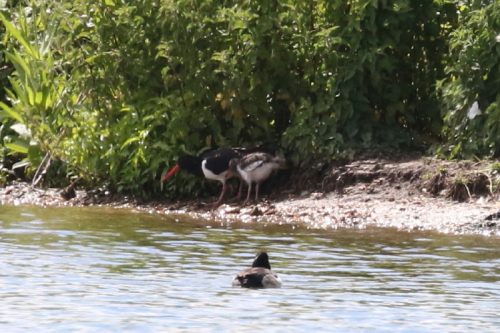
Oystercatcher and chick, Longham Lakes, 05/06/2020 (Alan Pearce)
5th June
The Oystercatcher pair is still around with the single chick (Alan Pearce.)
1st June
Cuckoo calling from Hampreston direction. 2 Oystercatchers on island in south lake with chick (Alan Pearce.)
